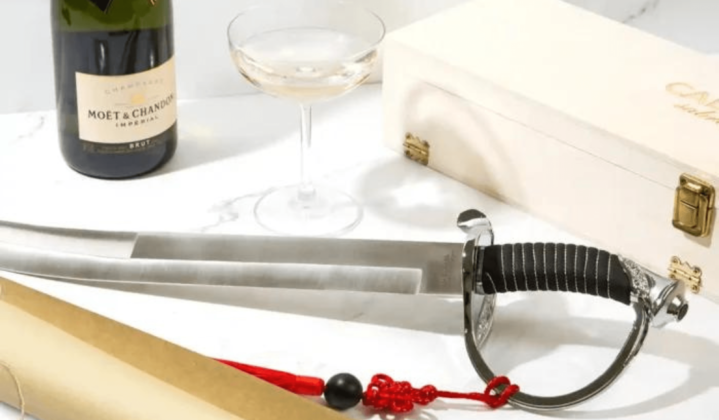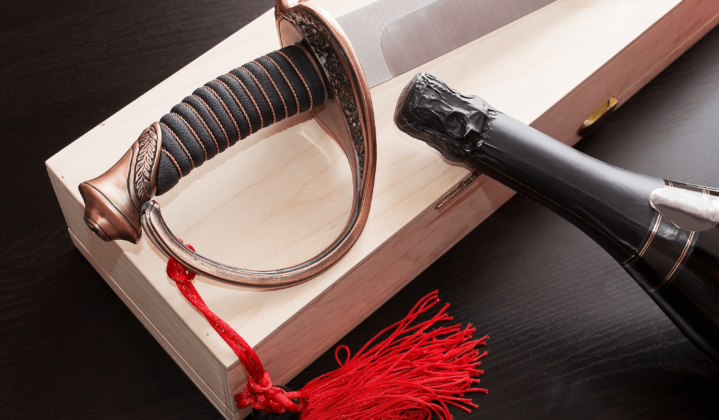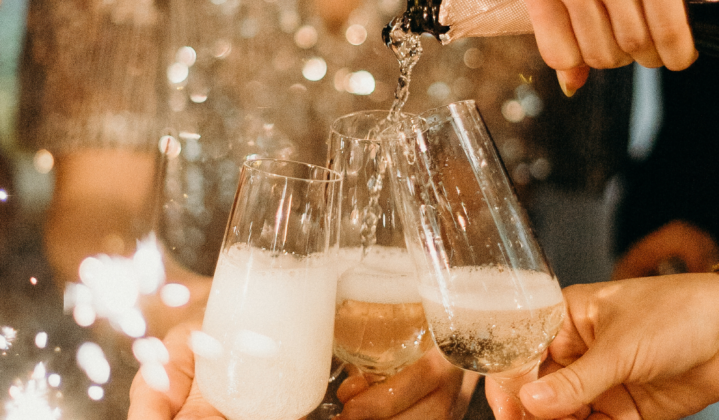What is a Champagne Saber? A Beginner's Guide for Sabering Champagne in 2025
Few traditions capture the spirit of celebration quite like Champagne sabering. With a swift stroke of a saber, the top of the bottle separates, sending the cork soaring and releasing a cascade of effervescent bubbles. It’s a striking display—one that transforms an ordinary toast into a moment of excitement and spectacle.
A Champagne saber is more than just a decorative blade; it’s a tool crafted specifically for this dramatic ritual. By gliding the saber along the bottle’s seam, the pressure within does the rest, ensuring a clean break and an unforgettable reveal. The act itself is steeped in history, turning the simple task of opening a bottle into an art form.
Mastering the technique isn’t just about style—it’s about embracing tradition, precision, and a touch of daring. Whether marking a milestone or simply elevating an evening, Champagne sabering brings an element of grandeur that lingers long after the last sip.
The History of Champagne Sabering

Origins and Historical Significance
The tradition of Champagne sabering dates back to the Napoleonic era, where it became a signature move of Napoleon Bonaparte’s cavalry officers. After the dust of battle had settled, these soldiers would celebrate their victories with a flourish—unsheathing their sabers and effortlessly slicing the tops off bottles of Champagne. This act wasn’t just about enjoying a drink; it was a powerful symbol of triumph, a display of both their bravery and their finesse. The sight of a sabered bottle became synonymous with victory, prestige, and the celebration of hard-won success. Over time, what began as a military ritual for the elite evolved into a symbol of luxury and festivity, carried forward by those who wished to mark their own moments of glory with the same dramatic flair. From the battlefields of Europe to the grand salons of high society, Champagne sabering has stood the test of time, becoming an enduring emblem of celebration and splendor.
Evolution Over Time
As the years passed, the art of Champagne sabering transformed from an exclusive military ritual into a cherished tradition at luxury events around the world. No longer confined to the ranks of soldiers, this practice began to grace the tables of society’s elite, adding a touch of grandeur to weddings, gala dinners, and festive gatherings. The tradition, once rooted in the heat of battle, found new life in the realm of celebration, where it became a way to elevate any occasion with historical charm and a bit of theatricality. Today, Champagne sabering is a beloved ritual for anyone seeking to infuse their event with a sense of occasion. The tools used have also evolved, with sabers designed specifically for this purpose, blending aesthetics with functionality. Whether in the hands of a seasoned sommelier or a first-time saberer, the act of sabering a bottle remains a captivating moment, uniting the elegance of the past with the joy of the present.
What is a Champagne Saber?

The Purpose Behind the Blade
Imagine a blade designed not for battle, but for celebration—a tool crafted to turn the simple act of opening a bottle of Champagne into a moment of spectacle. This is the essence of a Champagne saber. Unlike a typical knife or sword, the Champagne saber isn’t sharp along its edge. Instead, it uses the force of its broad, flat side to break the bottle’s neck with a swift, dramatic motion. The result is a clean, theatrical release of the cork and collar, sending them flying as the Champagne bubbles to the surface. The primary purpose of this ceremonial blade is to create an unforgettable experience, transforming a routine toast into an event that captures everyone’s attention.
Craftsmanship and Aesthetic: Materials and Design for Champagne Sabers
When it comes to the construction of a Champagne saber, the materials are chosen as much for their durability as for their beauty. Stainless steel is often the metal of choice for the blade, offering both strength and resistance to corrosion, ensuring that the saber maintains its pristine condition over time. The handle, however, is where the saber’s true character shines. Handles can range from sleek and minimalistic designs that emphasize functionality, to elaborate works of art adorned with intricate engravings, inlays of wood, ivory, or even precious metals. Each Champagne saber is designed to be perfectly balanced, providing the user with the precision needed to perform the sabering ritual with grace and ease. This blend of form and function ensures that the saber is not only a tool but also a statement piece, embodying the elegance of the occasion it serves.
Setting It Apart from Other Blades: Comparison with Other Sabers/Knives
Unlike any other blade, the Champagne saber is a tool of celebration, not combat. While traditional swords are crafted for cutting or defense, and ceremonial knives are designed for specific rituals, the Champagne saber has a unique purpose: creating a clean, dramatic break in the neck of a Champagne bottle. Its design emphasizes balance and precision, with a blunt edge that relies on the force of the strike rather than sharpness. This sets the Champagne saber apart from other blades, which are often designed for cutting or symbolic gestures, making it a one-of-a-kind tool specifically crafted to turn an ordinary bottle opening into an extraordinary event.
The Art of Sabering Champagne

Mastering the Technique: A Step-by-Step Guide
- Chill the Bottle: Start by thoroughly chilling the Champagne bottle. A well-cooled bottle reduces internal pressure, making the sabering process both smoother and safer.
- Prep the Bottle: Carefully remove the foil and gently loosen the wire cage, leaving it in place for added cork stability. This ensures the cork won’t pop prematurely.
- Identify the Seam: Find the seam running vertically along the bottle’s glass. This is the bottle’s weakest point and your ideal target for a clean saber.
- Angle the Bottle: Hold the bottle firmly at its base, tilting the neck upwards at a 45-degree angle. This position sets you up for a successful and controlled strike.
- Position the Saber: Place the saber’s flat side against the bottle, positioning the blade’s edge just behind the bottle’s lip, ready to slide forward.
- Strike with Precision: With a confident and fluid motion, glide the blade along the seam towards the lip. The cork and collar should break off cleanly, sending the cork flying and leaving you with a perfectly opened bottle.
- Celebrate the Moment: Immediately pour the Champagne and relish in the applause. This is your moment of triumph—enjoy every second of it!
Brings an extra dimension to the party: Preventing Common Sabering Errors
- Inadequate Chilling: If the bottle isn’t sufficiently chilled, the pressure can make the glass shatter or make sabering more difficult.
- Inconsistent Pressure: Too much or too little pressure during the strike can result in an uneven break or even a broken bottle.
- Incorrect Angle: Holding the bottle at the wrong angle can disrupt the saber’s path, leading to a stuck cork or an incomplete saber.
Ensuring a Safe Sabering Experience
- Wear Protective Gear: Consider wearing gloves and safety glasses to shield yourself from any potential flying glass shards.
- Clear Your Space: Ensure that the area in front of you is clear of people and delicate objects, and always point the bottle away from others.
- Use the Right Tool: Always saber with a proper Champagne saber or a tool specifically designed for this purpose. Avoid using kitchen knives or other unsuitable tools for sabering.
Selecting the Perfect Champagne Saber
Key Considerations for Your Purchase
When choosing a Champagne saber, you’re looking for a combination of elegance and functionality that elevates the sabering experience. Quality should be your top priority—seek out sabers made from premium materials like stainless steel, which offers durability and resistance to corrosion. Balance is another crucial factor; a well-balanced saber ensures a smooth and controlled sabering motion. The design of the saber is equally important, reflecting your personal style, whether you prefer minimalist sophistication or something more ornate and luxurious. The saber’s design should complement the atmosphere of the events where you plan to use it.
Top Picks and Brand Highlights
Several brands are known for crafting Champagne sabers that stand out in both form and function:
- Laguiole en Aubrac: Renowned for their craftsmanship, these French-made sabers often feature handles crafted from exotic materials like wood or horn, combining traditional techniques with artistic design.
- Berard France: Known for their sleek, contemporary designs, Berard France sabers offer ergonomic handles and high-quality stainless steel blades, making them ideal for those who value both style and performance.
- Claude Dozorme: This prestigious brand offers luxurious sabers with intricate engravings, often presented in elegant cases—perfect for special occasions and as treasured gifts.
Ideal Moments for Champagne Sabering

Perfect Occasions to Saber
Champagne sabering can turn any celebration into an extraordinary event. Weddings provide a classic setting, where the couple can create a memorable moment by sabering their first bottle of Champagne together. Milestone celebrations like anniversaries, significant birthdays, or retirements are also perfect opportunities to add the excitement of a sabered bottle, marking the occasion with style and elegance. Formal dinners or corporate events can be enhanced with a Champagne sabering, turning an ordinary toast into a show-stopping highlight. Even at casual gatherings, a well-timed sabering can bring an element of sophistication and unforgettable flair.
Respecting Tradition and Etiquette
While the act of sabering is thrilling, observing the proper etiquette enhances the experience. Always saber the bottle safely, with the neck pointed away from guests and fragile items. Following the sabering, it’s customary to offer an immediate toast, allowing everyone to share in the celebration. The person performing the sabering, often the host or a guest of honor, should approach the act with a sense of ceremony, acknowledging its historical significance. Presenting the sabered bottle to the guest of honor as a keepsake adds a thoughtful touch to the occasion, serving as a lasting memento of the event.
Champagne Sabering in Modern Celebrations

A Modern Celebration of Tradition
Champagne sabering has evolved from its origins among Napoleonic soldiers into a contemporary symbol of luxury and celebration. Today, sabering is often the highlight at upscale events, adding an element of exclusivity and excitement. Whether at private gatherings, high-end parties, or prestigious restaurant openings, the spectacle of sabering sets the stage for a lavish experience. Even in more intimate settings, the act of slicing open a Champagne bottle with a saber transforms a simple moment into something truly memorable, seamlessly blending tradition with modern festivity.
Sabering’s Influence in Pop Culture
Champagne sabering has become synonymous with extravagance and flair in popular culture. It has been prominently featured in films, TV shows, and music videos, often symbolizing success, celebration, or a life of luxury. These depictions have heightened its allure, inspiring celebrities and influencers to showcase their own sabering moments on social media. Whether on-screen or in real life, sabering continues to captivate audiences, representing the pinnacle of celebratory gestures and merging historical tradition with contemporary opulence.
Raise Your Glass to Unforgettable Moments
There’s something undeniably magical about turning the simple act of opening a bottle of Champagne into a moment that everyone will remember. An elegantly curved Champagne saber slashes through bottles with ease, creating an experience and a sense of occasion that lingers long after the bubbles have settled. It’s a blend of history, elegance, and a touch of daring that adds a unique flair to any celebration, whether you’re pouring Champagne, wine, or crafting the perfect cocktail.
Whether it’s your first time trying your hand at sabering or you’re adding to your collection of unforgettable moments, a Champagne saber is your key to transforming the ordinary into the extraordinary. Don’t just follow traditions—create your own. Ready to start your own tradition? Discover the perfect Champagne saber to begin your journey and become the centerpiece of every celebration.
Explore Our Collection of Champagne Sabers and start your own unforgettable tradition today.
Cheers for now, and happy sabering!
California Champagne Sabers
Frequently Asked Questions
1. Are champagne sabers sharp?
Champagne sabers are not designed to be sharp in the traditional sense, like a kitchen knife or a sword used in combat. Instead, the blade of a champagne saber is purposely blunt. The reason for this is that the saber is not meant to cut through the glass but to apply a firm, precise strike to the lip of the champagne bottle.
This strike, when performed correctly, creates enough pressure at the weakest point of the bottle, where the neck meets the cork, causing the glass to cleanly break away. The blunt edge ensures that the action is about the force and angle of the strike, not the sharpness of the blade. This design is a safety measure as well, making the act of sabrage more about technique than sharpness, reducing the risk of accidental injury during the celebration.
2. Can prosecco be sabered?
Yes, prosecco or sparkling white wine can be sabered, though it is less common than with champagne. The technique of sabrage can be applied to prosecco, but there are some differences to consider. Prosecco generally has a lower internal pressure than champagne, which means that the effect might be less dramatic. The lower pressure can result in a more controlled and less explosive release of the cork and bottle neck when sabered. It’s important to ensure that the prosecco is well-chilled before attempting to saber it, as this helps the glass neck to break cleanly. While the ritual of sabering prosecco is similar to that of champagne, it may require a slightly different angle or force to achieve the desired effect, but it remains an impressive and celebratory way to open a bottle.
3. Why do people shake champagne bottles?
Shaking a champagne bottle before opening it is often seen as a way to create a spectacular visual effect, where the cork is released with a dramatic spray of foam and bubbles. The shaking agitates the carbon dioxide within the champagne, increasing the pressure inside the bottle. This buildup of pressure causes the champagne to foam up and erupt forcefully when the cork is removed. However, while this can be visually impressive, it’s not recommended unless the goal is to create a celebratory mess, such as during a victory celebration in sports or at a lively party. For those who prefer to savor their champagne without losing half the bottle in a spray of bubbles, it’s better not to shake it. Additionally, shaking can make the bottle more unpredictable to open, increasing the risk of the cork flying off uncontrollably, which can be dangerous.
4. What makes a good champagne saber?
A good champagne saber is defined by a combination of its design, balance, and craftsmanship. Firstly, the handle of the saber should be sturdy and offer a comfortable, secure grip, allowing for controlled, confident movements. The blade itself is typically long, around 12 to 18 inches, and made from high-quality stainless steel, which ensures durability and resistance to corrosion. The weight of the blade is also important; it should be heavy enough to deliver a strong, steady strike but balanced so that it doesn’t feel unwieldy. Unlike a traditional sword, the blade of a champagne saber has a blunt edge, which is key to the sabrage technique, relying on force rather than sharpness to achieve a clean break. A good saber also has a well-crafted guard to protect the user’s hand during the process. The saber should not only be functional but also aesthetically pleasing, often featuring elegant designs or engravings that make it a worthy piece for display.
5. What is one of the most important rules when opening a bottle of champagne using a champagne saber?
Safety is paramount when opening a bottle of champagne using a saber, and the most important rule is to always ensure that the bottle is pointed away from people, animals, and fragile objects. When you strike the bottle with the saber, the top portion of the bottle, including the cork and a ring of glass, will be propelled forward with considerable force. This can potentially travel several feet, posing a danger to anything or anyone in its path. Additionally, it’s crucial to hold the bottle at a proper angle, usually around 30 to 45 degrees, and to maintain a firm grip on the neck of the bottle to prevent it from slipping. Another key safety measure is to ensure the champagne is sufficiently chilled before sabering, as this reduces the internal pressure and makes the glass more brittle, leading to a cleaner break. Wearing protective eyewear and gloves can also add an extra layer of safety. Following these precautions ensures that the ritual of sabrage remains a spectacular and safe experience.
